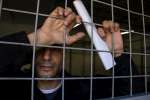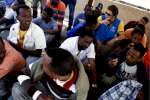- Text size
 |
|  |
|  |
| 
- Français
More than 1,500 drown or go missing trying to cross the Mediterranean in 2011
News Stories, 31 January 2012
GENEVA, January 31 (UNHCR) – The UN refugee agency on Tuesday released figures showing that more than 1,500 irregular migrants or refugees drowned or went missing last year while attempting crossings of the Mediterranean Sea.
"This makes 2011 the deadliest year for this region since UNHCR started to record these statistics in 2006. The previous high was in 2007 when 630 people were reported dead or missing," Senior Communications Officer Sybella Wilkes told journalists in Geneva, while adding that at least 18 people had drowned this year to date after setting off from Libya for Europe.
"Our teams in Greece, Italy, Libya and Malta, warn that the actual number of deaths at sea may be even higher," Wilkes said. "Our estimates are based on interviews with people who reached Europe on boats, telephone calls and e-mails from relatives, as well as reports from Libya and Tunisia from survivors whose boats either sank or were in distress in the early stages of the journey," she explained.
Wilkes also revealed that a record 58,000 irregular migrants, asylum-seekers and refugees managed to make it to European shores last year after setting off in boats from Asia or North Africa. The previous high was in 2008, when 54,000 people reached Greece, Italy and Malta.
During 2009 and 2010, border control measures sharply reduced the number of arrivals in Europe. The frequency of boat arrivals increased in early 2011 as the governments in Tunisia and Libya collapsed.
The majority of last year's arrivals by sea landed in Italy (56,000, of whom 28,000 were Tunisian) while Malta and Greece received 1,574 and 1,030 respectively. The majority arrived in the first half of the year and most were migrants, not asylum-seekers or refugees. Only three smuggler's boats arrived after mid-August.
UNHCR's Wilkes said that so far this year, "despite high seas and poor weather conditions," three boats had attempted the perilous journey from Libya and one of them – carrying 55 people – had gone missing.
"Libyan coastguards informed UNHCR that 15 dead bodies, all identified as Somali, were found washed up on the beaches [of Libya] last week, including 12 women, two men and a baby girl. On Sunday, three more bodies were recovered," Wilkes said. It was later confirmed that all those who drowned were Somali residents of the makeshift site in Tripoli known as the Railway Project.
The other two boats made it to Malta and Italy, but required rescuing. The Italian coastguard saved 72 Somalis, including a pregnant woman and 29 children, on January 13. The second boat was rescued two days later by the Maltese armed forces with the support of the US navy and a commercial vessel. In total 68 people were rescued from a drifting dinghy.
"UNHCR welcomes the ongoing efforts of the Italian, Maltese and Libyan authorities to rescue boats in distress in the Mediterranean. We renew our call to all shipmasters in the Mediterranean . . . to remain vigilant and to carry out their duty of rescuing vessels in distress," Wilkes said.












































